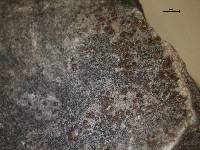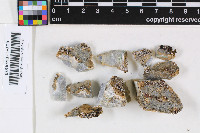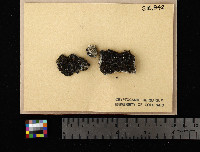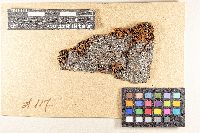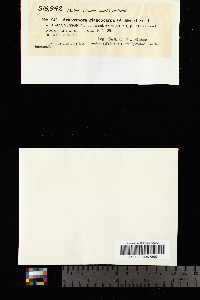
Consortium of Lichen Herbaria
- building a Global Consortium of Bryophytes and Lichens as keystones of cryptobiotic communities -
- Home
- Search
- Images
- Species Checklists
- US States: O-Z >
- US National Parks
- Central America
- South America
- US National Parks
- Southern Subpolar Region
|
|
|
|
Family: Acarosporaceae
[Acarospora cervina f. conspersa (Th. Fr.) Clauzade & Cl. Roux, moreAcarospora cervina f. depauperata Körb., Acarospora cervina var. glaucocarpa (Ach.) Körb., Acarospora glaucocarpa f. conspersa Th. Fr., Acarospora glaucocarpa f. glaucocarpa (Ach.) Körb., Acarospora glaucocarpa f. ostreata Anzi, Acarospora glaucocarpa var. conspersa Th. Fr., Acarospora glaucocarpa var. depauperata (Körb.) A.L. Sm., Acarospora glaucocarpa var. glaucocarpa (Ach.) Körb., Acarospora percaenoides (Nyl.) Flagey, Lecanora castanea f. percaenoides Nyl., Lecanora glaucocarpa (Ach.) Ach., Lecanora glaucocarpa f. conspersa (Th. Fr.) Cromb., Lecanora glaucocarpa f. glaucocarpa (Ach.) Ach., Lecanora glaucocarpa f. verrucosa Tuck., Lecanora glaucocarpa var. endocarpoides Vain., Lecanora glaucocarpa var. glaucocarpa (Ach.) Ach., Lecanora percaenoides Nyl., Lichen glaucocarpus (Ach.) Wahlenb., Myriospora glaucocarpa (Ach.) Hepp, Parmelia glaucocarpa Ach., Placodium glaucocarpum (Ach.) Müll.Arg.] |
Nash, T.H., Ryan, B.D., Gries, C., Bungartz, F., (eds.) 2007. Lichen Flora of the Greater Sonoran Desert Region. Vol 3. Thallus: areolate or squamulose, overall up to 4 cm wide squamules: round to irregular, often dividing with stipe splitting, 0.3-3 mm wide, up to 0.7 mm thick or more, dispersed or contiguous, sometimes apothecia becoming dilated and thallus reduced to lecanorine-like margin; rim: shallowly crenulate to irregular, with deep sinuses upper surface: brown, sometimes very dark, or gray, dull, plane to convex, smooth to fissured, epruinose or pruinose with white to blue-gray pruina lateral cortices: prosoplectenchymatous, irregular, rather indistinct in water, continuous, thinning into cortex of lower surface, 20-90 µm thick: syncortex: absent or 5-10 µm thick; eucortex: with hyphae emerging from algal layer, prosoplectenchymatous to paraplectenchymatous, with upper layer usually dark brown and lower layer hyaline, up to 80 µm thick algal layer: even especially in lecanorinelike areoles, but penetrated by hyphal bundles, and often becoming extremely uneven and jagged medulla: white, prosoplectenchymatous, continuous with attaching hyphae lower surface: white to brown, or substrate-stained attachment: broad, but especially in large sterile areoles, forming a stipe 1/3-2/3 diam. of the squamule Apothecia: usually 1 per thallus unit disc: brown, rough, epruinose or pruinose true exciple: indistinct or thin as parathecium or hypothecium (in North American specimens examined) epihymenium: brown or pale yellow, c. 10 µm thick, hymenium: hyaline, 60-120 µm tall; paraphyses: 1.7-2.1(-3) in diam. at base, conglutinated, with apices 2.5-6 µm wide subhymenium: slightly darker than the hymenium, 10-50 µm thick, hypothecium usually indistinct asci: usually narrowly cylindrical, height varying with hymenium, 12-16 µm wide but sometimes broader, 100+-spored ascospores: hyaline, simple, ellipsoid to broadly ellipsoid but sometimes poorly developed, (3-)4-5 x (1.5-)2-2.5(-2.7) µm Pycnidia: not observed Spot tests: UV-, all spot tests negative Secondary metabolites: none detected. Substrate and ecology: on carbonate rock, rarely on granite, in places seasonally flushed with water World distribution: United States and Mexico Sonoran distribution: rare in southern California (San Bernardino Mountains) and southeastern Arizona (Rincon Mountains). Notes: The description of A. glaucocarpa is based on North American specimens, which were not particularly variable except when growing on concrete. This treatment doesn't recognize epruinose North American specimens as var. cervina (currently only recognized among European specimens). The jagged algal layer is usually distinct, but specimens can be confused with A. badiofusca, which does not have a jagged algal layer and usually has narrower spores. Although it is closely related to Sarcogyne regularis (Reeb et al. 2004), A. glaucocarpa differs from Sarcogyne species in having an algal layer in the margins formed from the reduction or division of the thallus. Acarospora canadensis H. Magn. was applied to epruinose specimens of A. glaucocarpa in Canada (Holotype, CANL!) |
|
|
|
Powered by Symbiota
















































